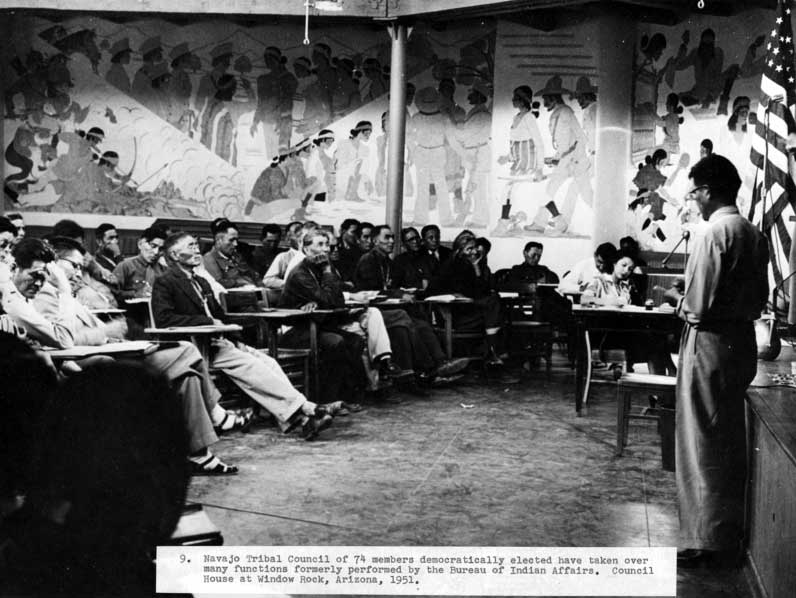
50 Years Ago: Nakai tries to take advantage of the fair

The Navajo Tribal Council originally consisted of 74 elected members who took over duties that had been performed by the Bureau of Indian Affairs. (Photo of Council in 1951 courtesy of Truman Library.)
As the 21st annual Navajo Tribal Fair was on the verge of starting, Navajo Tribal Chairman Raymond Nakai was reportedly feeling very good about the past year and he wanted to send a message to fairgoers.
He was, for the first time, in total control of the tribal government, having got enough supporters on the Council that he no longer had to fear the Old Guard. He also had control over the Navajo Times now that Chet MacRorie had been removed as editor and the chairman’s staff were running the paper.
Most of all, he wanted people to enjoy this year’s fair because he believed, as many in the tribal government believed, that the mood of voters after the fair reflected how they felt about the administration.If they enjoyed themselves, they would likely support the current chairman if he decided to run again. If they didn’t, the chairman would have a hard time getting that support back.
There was no talk, as there is today, of having the fair make a profit. So Nakai gave out lots of free passes to the fair. He admitted to giving out a few hundred but, according to the report fair officials gave to the Council later, it was probably in the thousands.
Another major change in 1967 was that the police department made a major effort to increase the number of officers in the fairgrounds during major events because of complaints about intoxicated persons wandering around the fairgrounds, begging for money or making a nuisance of themselves.
While other law enforcement agencies would help out each year by providing one or two officers to help out, Nakai made a plea to the county sheriffs and state police to provide more officers this year.
The big attraction that year was the appearance of U.S. Vice President Hubert Humphrey, who was scheduled to be in the parade as well as speak on Saturday morning, shorty after he arrived by plane.
No one knew in advance what he was going to say but Nakai’s officials were hoping he would announce some new grants because it was a policy of he White House to come bearing gifts when they visited any tribe.
Nakai was particularly excited because Humphrey was planning to spend Saturday night at his home in Window Rock. He had been preparing for weeks, listening to suggestions from everyone on how to keep the vice president entertained.
At the last minute, however, the White House announced Humphrey would be spending only seven hours at the fair and would leave Saturday night because of plans to spend Sunday in California.
Nakai, interviewed later, said he was disappointed but understood perfectly that national leaders had to limit their time at any one event so they could meet as many people as possible.
Because of the expected crowds – 29,000 to 30,000 – a lot of politicians from on and off the reservation were planning to set up booths on the Saturday of the fair to pass out literature or just be seen by prospective voters.
One of the big differences in the fair back in 1967 to the one today is that it had two fair parades – one on Friday and the other on Saturday and both would have a lot of participants.
The candidates for Miss Navajo that year were Lucinda Yellowman (Shiprock Agency), Thelma Pablo (Eastern), Katherine Dahozy (Fort Defiance), Sarah Brown (Chinle) and Rosita Isaac (Tuba City).
Admission to the fairgrounds (for those unfortunate enough not to get a free pass) was $1 for adults and 50 cents for children. The admission cost of the rodeo was $2 for adults and $1 for children.
The fair issue of the Times that year was 54 pages with a lot of companies that did business with the tribe paying $105 for a full page to show their support of the Navajo people. There were seven photos of Nakai sprinkled throughout the issue with one almost a quarter page on page 6 welcoming people to the fair.
The fair that year was not without its own tragedy when a two-car head-on collision killed five people from Crownpoint and Tohatchi.
The accident took place early Sunday morning on State Highway 264 near Yah-Ta-Hey, New Mexico.
In those days, Highway 264 was two lanes and was one of the most dangerous roads in the country because of drunk drivers. Police later said the accident was caused by one of the vehicles going into the wrong lane at the top of a hill and hitting the other one head-on, demolishing both cars.
The driver of the car that went into the wrong lane was one of those killed in the accident. State police said weather was a major factor in the accident as it was raining heavily and the roads were slick. Visibility was less than an eight of a mile.
The car that drove into the wrong lane had a sticker on it showing it had been purchased only two days before the accident.
The Gallup Independent came under heavy criticism from some traditional Navajos for having a huge photo on the front page the Monday after the fair showing one of the cars. The driver of the vehicle could be seen clearly in the photo and the paper was criticized for being insensitive to Navajo traditional beliefs about death.
To read the full article, pick up your copy of the Navajo Times at your nearest newsstand Thursday mornings!
Are you a digital subscriber? Read the most recent three weeks of stories by logging in to your online account.








 Highway 264,
Highway 264, I-40, WB @ Winslow
I-40, WB @ Winslow